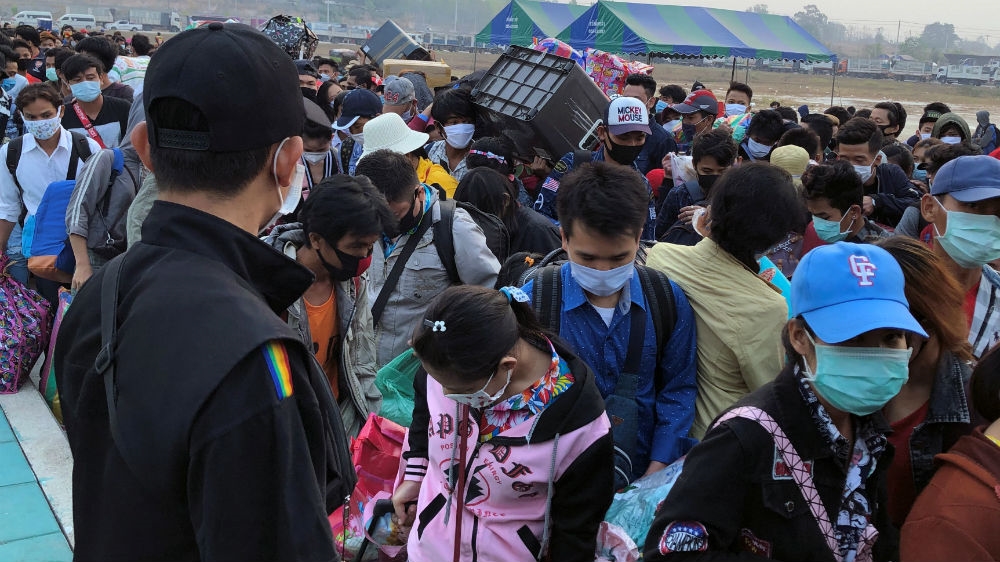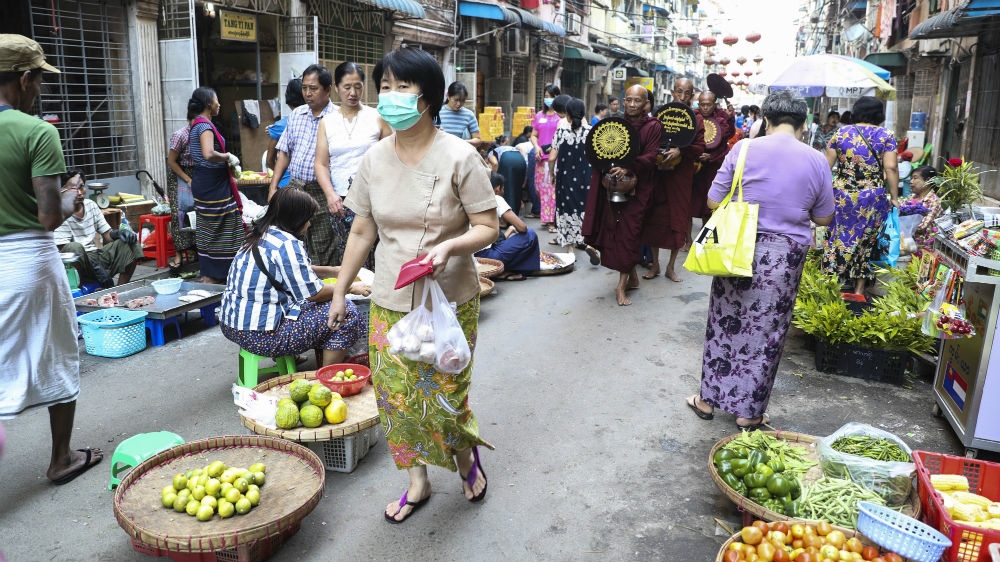Fears of coronavirus catastrophe as Myanmar reports first death
Government says it is on top of the outbreak, but experts worry the disease has already been circulating for some time.

Yangon, Myanmar – Myanmar is braced for a “major outbreak” after one of the thousands of migrants returning from Thailand tested positive for the new coronavirus, and the country recorded its first COVID-19 death on Tuesday.
Myanmar confirmed its first two cases on March 23, in two people who had travelled to the United States and the United Kingdom, but that number has now climbed to 14.
Keep reading
list of 3 itemsYour coronavirus emergency kit: Five workouts to do at home
‘Stuck’: Hope fades for refugees in Malaysia as US closes door
Andrew Tatem, an epidemiologist at the University of Southampton, said it was “quite likely” the virus arrived in Myanmar earlier.
“The countries surrounding Myanmar reported cases … much earlier, and there is usually substantial mobility in the region,” he said via email, adding that more widespread testing would be expected to find more cases.
Myanmar shares a 2,000-kilometre-long (1,243 miles) border with China, crossed by an estimated 10,000 workers on a daily basis. Before they were stopped, the country also had direct flights to Wuhan, the city where the pandemic first began.
Slow off the mark
Myanmar has also been slow to institute widespread testing, with only 517 people tested as of the end of March. Even this low number is a marked increase, given that Myanmar had tested less than 150 people by March 18. It was only on March 20 that the health minister announced a new policy to test for anybody with symptoms, not just recent travellers.

“To find 10 cases from 300 tests suggests that there are many more cases out there and scaling up testing should be a priority to get on top of the virus spread and guide response,” Tatem said.
The United Nations has announced a plan to donate 50,000 testing kits to Myanmar, supplementing previous donations of 3,000 from Singapore and 5,000 from South Korea.
Khin Khin Gyi, spokesperson for the Ministry of Health, admitted it was possible the virus arrived in Myanmar earlier, but said a certain percentage of those cases would presumably have been “severe” and therefore would have come to the government’s attention.
Joshua Poole, country director for Catholic Relief Services Myanmar, agreed that if there were widespread cases across the country, the news would be circulating on social media. Poole also chairs the Steering Committee of the International NGO Forum in Myanmar and has sat in on virtual meetings between the WHO, UN, and Ministry of Health.
“We’re having some challenges in terms of getting more tests out there. In my perspective, it seems like the government is doing everything they can. Obviously, there are some challenges, and there certainly seems to be some delays, but I’m actually quite impressed with what the ministry is able to do,” he said in a recent interview.
Others, like independent analyst David Mathieson, are less impressed.
“The public health system in Myanmar is woefully unsuited to responding to a pandemic on this scale, so it will be hard to assess how long COVID-19 has been in the country and how many people have perished but had deaths recorded under other causes,” he said.
Mathieson said the government was slow to respond due to a “toxic mixture of incompetence, a culture of denial, and ultra-nationalist bluster.”
Health Minister Myint Htwe set the unrealistic goal of zero cases and zero deaths, while government spokesman Zaw Htay said Myanmar was protected by its lifestyle, diet, and lack of credit cards.
While Myanmar did begin to take action once cases were confirmed, Mathieson is worried the government lost more than a month’s worth of time.
Return from Thailand
Tens of thousands of migrant workers returned from Thailand last week as the borders were closed, which Tatem said has “the potential to seed outbreaks across the country if there are not local outbreaks occurring already”.
The migrants crowded across the border before boarding buses with the general population and dispersing throughout the country.
Khin Khin Gyi said the government had “planned a lot” for the return of migrants from Thailand.
“We had social distancing at the immigration counter, a medical declaration form, we took their names and residences in the country,” she said.

She added that local authorities were informed of their whereabouts so they can “watch” returnees, and soon the government will implement community quarantine measures and violators will face legal action. “Some people do not follow the home quarantine,” she said.
But locals and activists working with migrants said the government response had been unsatisfactory.
Alexa Bay, director of anti-trafficking group Daughters Rising, said migrant workers belatedly heard about self-isolation policies from local news.
“They have not heard anything from the government,” she said.
Wahkushee Tenner, a Karen activist, said the chaotic return had put the migrants and local population at risk.
“These people are at the most risk of being infected if anyone among this big crowd is infected. It’s really putting the local community at high risk where there is no test available, and most of these workers came from poor and remote areas,” she said in a message.
Tenner said the government does not have the capacity to contain the virus, and criticised the military for being too “busy bombing and killing in Rakhine State and other ethnic areas.”
“In a global epidemic situation it would be good to see the end of offensives against ethnic people,” she said.
Those living in Myanmar’s makeshift camps for people displaced by civil conflict are also bracing for a possible crisis. Human Rights Watch called the camps, which are home to an estimated 350,000 people, “COVID-19 tinderboxes”.
“Years of conflict, neglect, and abusive policies by Myanmar’s government and military have left hundreds of thousands of displaced people sitting in the path of a public health catastrophe,” said HRW’s Asia Director Brad Adams in a statement.
‘Knife’s edge’
Myanmar’s poor also face the difficult choice between potentially exposing themselves to the virus, or taking an income hit they simply cannot afford.
“Many Myanmar people live on a knife’s edge of livelihoods and food security,” said Mathieson. “Myanmar’s poor will be the ones who suffer the most from any pandemic, and any extended shutdown without significant government and private food supplies and sustainability will drive many communities to desperation.”

Even as restaurants and bars across Yangon shut down over the weekend, taxi drivers continued calling out to the rare pedestrians on the street, offering rides.
They said they knew the risk, but felt they had no other choice. “If I don’t drive, I don’t eat,” said one.
Bay works with domestic workers who feel the same way.
“Some of the girls who are domestic workers think that their job is risky now, and they are worried that they come in contact with people that have the virus … but they don’t feel they can refuse because they are afraid they will be fired,” she said.